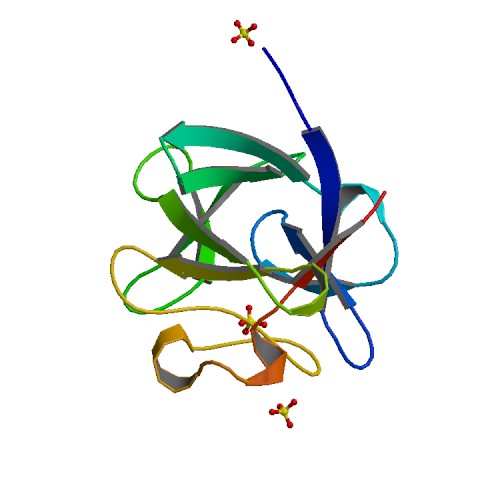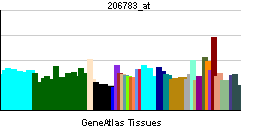FGF4
| Fibroblast growth factor 4 (heparin secretory transforming protein 1, Kaposi sarcoma oncogene) | |||||||||||||
|---|---|---|---|---|---|---|---|---|---|---|---|---|---|
 PDB rendering based on 1ijt. | |||||||||||||
| |||||||||||||
| Identifiers | |||||||||||||
| Symbols | FGF4 ; HBGF-4; HST; HST-1; HSTF1; K-FGF; KFGF | ||||||||||||
| External IDs | Template:OMIM5 Template:MGI HomoloGene: 1522 | ||||||||||||
| |||||||||||||
| RNA expression pattern | |||||||||||||
 | |||||||||||||
| More reference expression data | |||||||||||||
| Orthologs | |||||||||||||
| Template:GNF Ortholog box | |||||||||||||
| Species | Human | Mouse | |||||||||||
| Entrez | n/a | n/a | |||||||||||
| Ensembl | n/a | n/a | |||||||||||
| UniProt | n/a | n/a | |||||||||||
| RefSeq (mRNA) | n/a | n/a | |||||||||||
| RefSeq (protein) | n/a | n/a | |||||||||||
| Location (UCSC) | n/a | n/a | |||||||||||
| PubMed search | n/a | n/a | |||||||||||
Fibroblast growth factor 4 (heparin secretory transforming protein 1, Kaposi sarcoma oncogene), also known as FGF4, is a human gene.[1]
The protein encoded by this gene is a member of the fibroblast growth factor (FGF) family. FGF family members possess broad mitogenic and cell survival activities and are involved in a variety of biological processes including embryonic development, cell growth, morphogenesis, tissue repair, tumor growth and invasion. This gene was identified by its oncogenic transforming activity. This gene and FGF3, another oncogenic growth factor, are located closely on chromosome 11. Co-amplification of both genes was found in various kinds of human tumors. Studies on the mouse homolog suggested a function in bone morphogenesis and limb development through the sonic hedgehog (SHH) signaling pathway.[1]
References
Further reading
- Powers CJ, McLeskey SW, Wellstein A (2000). "Fibroblast growth factors, their receptors and signaling". Endocr. Relat. Cancer. 7 (3): 165–97. PMID 11021964.
- Galland F, Stefanova M, Lafage M, Birnbaum D (1992). "Localization of the 5' end of the MCF2 oncogene to human chromosome 15q15----q23". Cytogenet. Cell Genet. 60 (2): 114–6. PMID 1611909.
- Taira M, Yoshida T, Miyagawa K; et al. (1987). "cDNA sequence of human transforming gene hst and identification of the coding sequence required for transforming activity". Proc. Natl. Acad. Sci. U.S.A. 84 (9): 2980–4. PMID 2953031.
- Delli Bovi P, Curatola AM, Kern FG; et al. (1987). "An oncogene isolated by transfection of Kaposi's sarcoma DNA encodes a growth factor that is a member of the FGF family". Cell. 50 (5): 729–37. PMID 2957062.
- Yoshida T, Miyagawa K, Odagiri H; et al. (1987). "Genomic sequence of hst, a transforming gene encoding a protein homologous to fibroblast growth factors and the int-2-encoded protein". Proc. Natl. Acad. Sci. U.S.A. 84 (20): 7305–9. PMID 2959959.
- Wada A, Sakamoto H, Katoh O; et al. (1989). "Two homologous oncogenes, HST1 and INT2, are closely located in human genome". Biochem. Biophys. Res. Commun. 157 (2): 828–35. PMID 2974287.
- Huebner K, Ferrari AC, Delli Bovi P; et al. (1989). "The FGF-related oncogene, K-FGF, maps to human chromosome region 11q13, possibly near int-2". Oncogene Res. 3 (3): 263–70. PMID 3060803.
- Adelaide J, Mattei MG, Marics I; et al. (1988). "Chromosomal localization of the hst oncogene and its co-amplification with the int.2 oncogene in a human melanoma". Oncogene. 2 (4): 413–6. PMID 3283658.
- Ornitz DM, Xu J, Colvin JS; et al. (1996). "Receptor specificity of the fibroblast growth factor family". J. Biol. Chem. 271 (25): 15292–7. PMID 8663044.
- Helland R, Berglund GI, Otlewski J; et al. (1999). "High-resolution structures of three new trypsin-squash-inhibitor complexes: a detailed comparison with other trypsins and their complexes". Acta Crystallogr. D Biol. Crystallogr. 55 (Pt 1): 139–48. doi:10.1107/S090744499801052X. PMID 10089404.
- Bellosta P, Iwahori A, Plotnikov AN; et al. (2001). "Identification of receptor and heparin binding sites in fibroblast growth factor 4 by structure-based mutagenesis". Mol. Cell. Biol. 21 (17): 5946–57. PMID 11486033.
- Britto JA, Evans RD, Hayward RD, Jones BM (2002). "From genotype to phenotype: the differential expression of FGF, FGFR, and TGFbeta genes characterizes human cranioskeletal development and reflects clinical presentation in FGFR syndromes". Plast. Reconstr. Surg. 108 (7): 2026–39, discussion 2040-6. PMID 11743396.
- Yamamoto H, Ochiya T, Tamamushi S; et al. (2002). "HST-1/FGF-4 gene activation induces spermatogenesis and prevents adriamycin-induced testicular toxicity". Oncogene. 21 (6): 899–908. doi:10.1038/sj.onc.1205135. PMID 11840335.
- Sieuwerts AM, Martens JW, Dorssers LC; et al. (2003). "Differential effects of fibroblast growth factors on expression of genes of the plasminogen activator and insulin-like growth factor systems by human breast fibroblasts". Thromb. Haemost. 87 (4): 674–83. PMID 12008951.
- Koh KR, Ohta K, Nakamae H; et al. (2002). "Differential effects of fibroblast growth factor-4, epidermal growth factor and transforming growth factor-beta1 on functional development of stromal layers in acute myeloid leukemia". Leuk. Res. 26 (10): 933–8. PMID 12163055.
- Lopez-Sanchez C, Climent V, Schoenwolf GC; et al. (2003). "Induction of cardiogenesis by Hensen's node and fibroblast growth factors". Cell Tissue Res. 309 (2): 237–49. doi:10.1007/s00441-002-0567-2. PMID 12172783.
- Wang P, Branch DR, Bali M; et al. (2003). "The POU homeodomain protein OCT3 as a potential transcriptional activator for fibroblast growth factor-4 (FGF-4) in human breast cancer cells". Biochem. J. 375 (Pt 1): 199–205. doi:10.1042/BJ20030579. PMID 12841847.
- Reményi A, Lins K, Nissen LJ; et al. (2003). "Crystal structure of a POU/HMG/DNA ternary complex suggests differential assembly of Oct4 and Sox2 on two enhancers". Genes Dev. 17 (16): 2048–59. doi:10.1101/gad.269303. PMID 12923055.
- Hirai K, Sasaki H, Yamamoto H; et al. (2004). "HST-1/FGF-4 protects male germ cells from apoptosis under heat-stress condition". Exp. Cell Res. 294 (1): 77–85. doi:10.1016/j.yexcr.2003.11.012. PMID 14980503.
| This protein-related article is a stub. You can help Wikipedia by expanding it. |